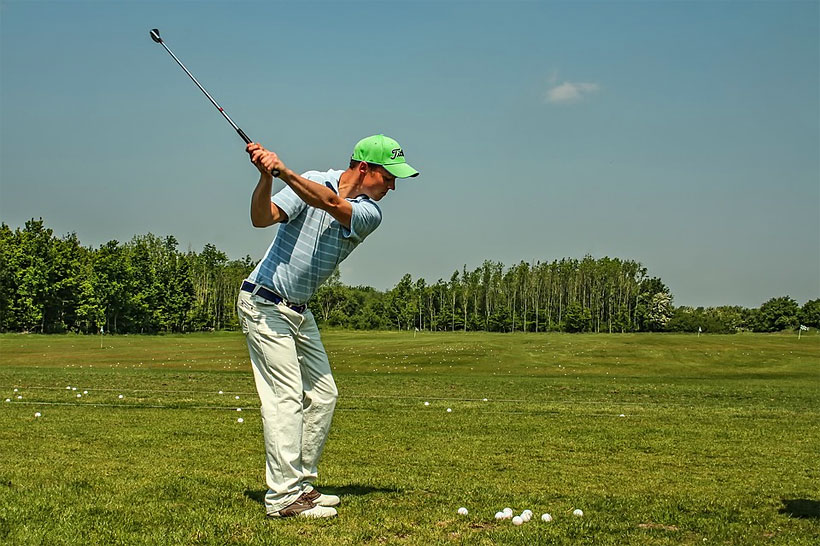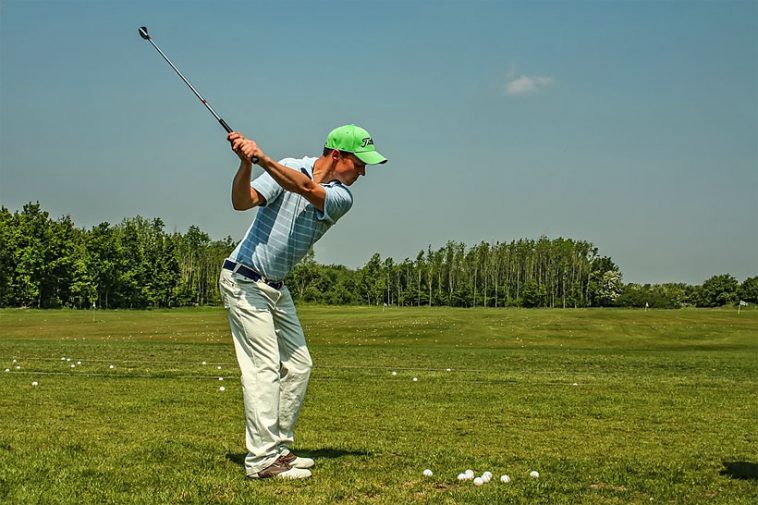- Like
- SHARE
- Digg
- Del
- Tumblr
- VKontakte
- Flattr
- Buffer
- Love This
- Save
- Odnoklassniki
- Meneame
- Blogger
- Amazon
- Yahoo Mail
- Gmail
- AOL
- Newsvine
- HackerNews
- Evernote
- MySpace
- Mail.ru
- Viadeo
- Line
- Comments
- Yummly
- SMS
- Viber
- Telegram
- JOIN
- Skype
- Facebook Messenger
- Kakao
- LiveJournal
- Yammer
- Edgar
- Fintel
- Mix
- Instapaper
- Copy Link
Introduction
 The sun has arrived and that means it’s time to grab those clubs and hit the green!
The sun has arrived and that means it’s time to grab those clubs and hit the green!
Aside from solid practice at the driving range, adding a structured workout routine can greatly improve your golf game by making you stronger and more efficient with your power.
Improving your golf game is also one of those things that takes time and effort, but it can be a truly rewarding process—especially as you keep at it and watch it pay off.
Seven Key Tips to Improve Your Golf Game
With all this in mind, here are seven great tips for improving your golf game.
Use Golf Swing Trainers
One of the best things you can do to improve your golf swing game is to practice with golf swing trainer cuff sets. Because so much of the game revolves around correct posture and stance, golf swing trainers can help you by forcing you to swing your arms together in ways that lead to better golf.
Getting properly aligned becomes much easier when you’re using golf swing trainers. Setting up square has never been so easy, thanks to the rod in the golf swing trainer sets.
Rotation is another area where golf swing trainers shine. When the rod is at perpendicular position, you’re ready for a great downswing.
Finally, during the swing, the cuffs swivel to allow for the kind of movement that will help you connect while staying fully synchronized.
Work on Hitting Straighter
It’s always tempting to focus on your distance, but if you focus on hitting straighter, you’ll actually improve more readily than if you focus on trying to increase your distance first.
Focus on straighter rather than farther, and you’ll master the fundamental relationship between the face of the club and the path of your swing. This will give you a much greater degree of control over the ball when you hit it.
As you work on hitting the ball straighter, you’ll find over time that you’re also able to hit it farther. The long and the short of it is that by working on your straight shot, you’ll become more efficient.
Establish Your Feel on Shorter Shots
Establish your feel on shorter shots, about 15-45 yards, and get your swing in sync before attempting anything with a longer club. This is fundamentally about warming up: what you want is to be able to have a good sense of your swing on your short game—similar to the above, in some ways.
By working on your short game first, you’ll be better when you go to the longer game.
Work on Your Drive
With tee shots, your posture makes all the difference. Begin with a good stance: hold your feet a little farther apart than the width of your shoulders, a bit like defense in basketball.
Then, focus on coiling up for the shot, and use your legs and lower half to drive the shot. Some people make the mistake of using their arms here, but this is a mistake: the power should be coming from your lower half.
The amateur way of doing this is to aim in a straight fashion, down the fairway. This leads to slicing, either in one direction or another.
A better way, that favored by professionals, is to curve the shot and adjust, correcting for your own errors. If your shots are going off toward the right, adjust to the left, and vice-versa.
Some of the golf-oriented exercises we’ve discussed before can also help you in this regard.
Learn Where You Make Impact
Here’s a tip that will really set you apart from most golfers: learn where your impact location is. The vast majority of golfers have no idea where they are making contact, where their irons are hitting the ball and giving it its proverbial marching orders.
The simple expedient of a dry erase marker or a can of Dr. Scholls Odor X can help you ascertain where your clubs make contact, and this information can help you to become a better golfer. After all, if you know where you’re hitting, you can adjust your swings accordingly to maximize your advantage.
Tempo Matters
The tempo at which you drive your golf swing is very important, since getting to great golf means becoming a master of repetition. Timing is everything, and having a sense of your tempo will help you master a sense of timing.
One thing you can do here is work with beats. When you know the beat you are using, you will have a sense of the rhythm of your own swings and thus a better sense of when you are hitting. This is a potentially great source of advantage.
Putting Practice Makes Perfect
Putting is one of those skills that you’ll want to dedicate some significant amount of time to work on if you really want to improve your golf game. It’s quite common for golfers to ignore this part of the game, but they do so at the cost of greater effectiveness.
It’s also important that you work out off the course, too. Face pulls, seated rotations, hand walks, and more are among the top exercises for golfers.
Work on successfully making more putts within 10 feet, work on speed control, and work on squaring the putter at impact, and you’ll find it leads to a better game overall.
Five Exercises to Greatly Improve Your Golf Swing
Here we have five great exercises to try that can really add some more range to those drives!
Perpendicular Medicine Ball Tosses
Stand sideways, with your shoulder facing the wall. Using a medicine ball of moderate weight, not too heavy, bring it across your body and toss it against the wall, repeating for 8-10 reps, then perform on the other side as well. Med Ball Tosses are a great way to activate your abdominals, as well as your obliques and hip flexors, and are great at developing rotational power and speed with your swing. Ensure to drive your outside hip towards the wall, to avoid using your arms and shoulders as the prime movers in this exercise. After each toss, your hips should be parallel to the wall, rotating off the front of the feet, exhaling through the toss with a braced core. (remember to perform dynamic stretching before doing this exercise).
Barbell Hip Thrusts
Using a bench, and barbell, lie back with your shoulders and upper back across the bench, with your hips towards the floor, allowing the bar to rest across your hips. Place a padding across your hips if needed, and use a moderate amount of weight for 8-10 reps. Keeping your core braced, squeeze your glutes to extend the hips upward, thrusting the bar with explosiveness but maintaining control through the lift. Ensure to always keep your feet grounded, driving from the heels to activate your glutes, hamstrings and keeping your core braced for support. The Hip Thrust is a great exercise for focussing on hip power and explosiveness, and for keeping our glutes working hard!
Anti-Rotation Banded Walk Out
Hook a resistance band on an anchor and create tension by walking away from the anchor, extending the arms in front of you, keeping your hands directly in line with your midline. Staying in this position, walk farther and farther, resisting the urge to rotate toward the anchor, then slowly walk back. Perform this movement for 8-10 reps per side, for 3-4 sets. The banded walk out is a great exercise for training the core to remain stable under tension, adding some endurance to the abdominal muscles and helping to maintain hip control during those big swings.
BOSU Ball Goblet Squat
Using a device, such as a bosuball, is a great way to challenge your balance and to improve your efficiency in sport and exercise. Use a moderate weight and carefully stand on the flat side of the bosuball. Maintain the weight to your sternum, just below your chin and keep your chest up, and back straight. Maintain a braced core and descend slowly into your squat, focussing on balance and making mental note of any points of instability. Descend to your comfort level and work towards greater depth with time and practice. Exhale through standing and create external rotation in the legs, through the feet, feeling your glutes and hamstrings push you through extension. This is a great exercise for developing not only explosive power but great balance and coordination through both legs individually.
Single Leg Deadlift
Hold a dumbbell in one arm and keep the opposing leg fixed to the ground, hinging from the hips and extending the opposite leg into the air, forming a “T” with the body. Keep the shoulders and spine neutral, as that is a major focus of the movement is resisting the urge for the weighted shoulder to drop. Use your core stability to keep your body straight and use the glute and hamstring of the down leg to extend you upright. Perform 9-10 reps per leg, 3-4 sets per leg. The single leg dumbbell deadlift is a great exercise for developing single leg balance and strength, helping to keep you more grounded in your golf swing, and allowing the energy transfer in your body to be more efficient.
Conclusion
Improving your golf game will take a lot of time and practice, but the tips here will get you off to a good start. Over time, you’ll be able to improve on the skills we’ve discussed here, and many others we have not.
About Shannon Clark
Shannon holds a degree in Exercise Science and is a certified personal trainer and fitness writer with over 10 years of industry experience.

